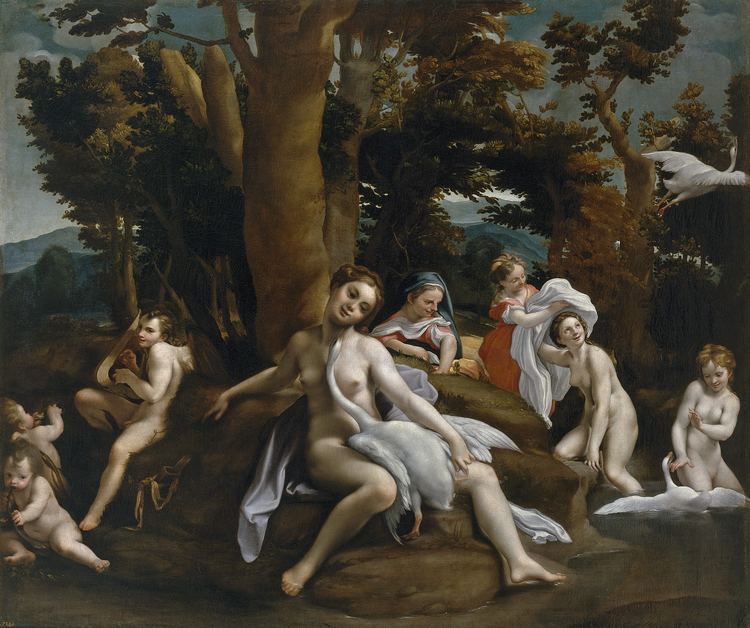 | ||
Similar | ||
In Greek mythology, Leda (/ˈliːdə, ˈleɪ-/; Greek: Λήδα [lɛ͜ɛ́da͜a]) was daughter of the Aetolian king Thestius, and wife of king Tyndareus (Τυνδάρεως) of Sparta. Her myth gave rise to the popular motif in Renaissance and later art of Leda and the Swan. She was the mother of Helen (Ἑλένη) of Troy, Clytemnestra (Κλυταιμνήστρα), and Castor and Pollux (Κάστωρ καὶ Πολυδεύκης, also spelled Kastor and Polydeuces).
Leda was admired by Zeus, who seduced her in the guise of a swan. As a swan, Zeus fell into her arms for protection from a pursuing eagle. Their consummation, on the same night as Leda lay with her husband Tyndareus, resulted in two eggs from which hatched Helen (later known as the beautiful "Helen of Troy"), Clytemnestra, and Castor and Pollux (also known as the Dioscuri (Διόσκουροι)). Which children are the progeny of Tyndareus the mortal king, and which are of Zeus and thus half-immortal, is not consistent among accounts, nor is which child hatched from which egg. The split is almost always half mortal, half divine, although the pairings do not always reflect the children's heritage pairings. Castor and Pollux are sometimes both mortal, sometimes both divine. One consistent point is that if only one of them is immortal, it is Pollux. It is also always stated that Helen is the daughter of Zeus.
Leda also had other daughters by Tyndareus: Timandra (Τιμάνδρα), Phoebe (Φοίβη), and Philonoe (Φιλονόη).
In Homer's Iliad, Helen looks down from the walls of Troy and wonders why she does not see her brothers among the Achaeans. The narrator remarks that they are both already dead and buried back in their homeland of Lacedaemon, thus suggesting that at least in the Homeric tradition, both were mortal.
Another account of the myth states that Nemesis (Νέμεσις) was the mother of Helen, and was also impregnated by Zeus in the guise of a swan. A shepherd found the egg and gave it to Leda, who carefully kept it in a chest until the egg hatched. When the egg hatched, Leda adopted Helen as her daughter. Zeus also commemorated the birth of Helen by creating the constellation Cygnus (Κύκνος), the Swan, in the sky.
Leda and the swan and Leda and the egg were popular subjects in ancient art. In the post-classical arts, it became a potent source of inspiration. It is the subject of William Butler Yeats' poem Leda and the Swan.
